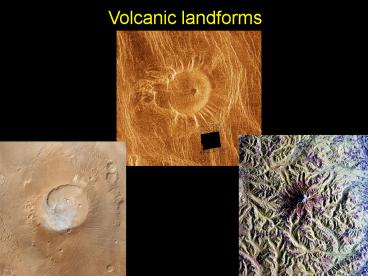Volcanic landforms PowerPoint PPT Presentation
1 / 21
Title: Volcanic landforms
1
Volcanic landforms
2
Landforms and eruption type
Explosive (mainly important on Earth)
cone-shaped volcano large collapse
caldera Effusive (important throughout solar
system) shield volcano flood basalt
plains cinder cones calderas (on large
shield volcanoes)
3
Explosive eruptions on Earth produce cone-shaped
composite volcanoes like Mount Shasta. Composite
volcanoes are made of layers of ash and lava.
4
Viscous magmas that do not contain enough gas to
explode will ooze out to form steep-sided lava
domes. These domes can sometimes subsequently
explode.
5
When a large explosive eruption draws enough
magma from beneath the surface, the upper layers
of rock collapse down into the space created.
This creates a large bowl-shaped feature called a
volcanic caldera. Crater Lake, shown here, sits
in the caldera formed by the eruption of Mount
Mazama.
6
Low-viscosity basalts erupt effusively and run
outwards to form very broad-sided cones with a
flat, shield-like profile. Effusive eruptions
from a central vent thus form shield volcanoes.
shield
7
Large shield volcanoes can have calderas on their
summits, as seen in this oblique view of the
shield volcano Olympus Mons on Mars, the largest
volcano in the solar system.
8
More gas-rich basaltic lavas will produce
fragments of cooled, bubbly glass called cinders.
These pile up to form cinder cones, as seen here
at Lava Butte, Oregon.
9
Flood basalt eruptions are effusive eruptions
that produce huge quantities of lava, mostly from
rifts rather than from a central vent. Instead
of forming a single volcano, these basalts spread
out to form broad, flat plains. Most of
eastern Washington state is covered with flood
basalts.
This sinuous lava channel on Venus is over 2000
km long
10
If water is present near a volcano, the hot rock
can heat up the water and produce hot springs (as
seen here, at Yellowstone), geysers, and other
geothermal features. This can produce
distinctive rock formations.
11
A great deal of volcanism on Earth is controlled
by plate tectonics. As the other terrestrial
planets lack plate tectonics, Earths hotspot
volcanism provides the best analogies for
volcanoes on other planets. Most hotspot
volcanism is basaltic, but some hotspots (on
continents) produce large explosive
eruptionslike Yellowstone.
12
(No Transcript)
13
Basaltic rocks on the surface of Venus, imaged by
Venera 13
14
These volcanic cones are too small to see many
details of their structure.
Shield volcanoes on Venus are formed by very
runny lavas, so they are made up of many long,
narrow flows. The volcano at upper left is a
type called an anemone volcano.
15
Volcanism on Venus apparently also produces some
more viscous lavas, because we see steep-sided
dome volcanoes that look like very large versions
of lava domes on Earth. The form at right is
called a tick volcano. Those on the left are
sometimes called pancake domes because they are
so flat.
16
Lava flows (and tectonic features) on Venus This
flow has ponded against and cross-cut a tectonic
ridge
17
Volcanic features on Mars
18
Basaltic rocks on Mars, imaged by the Viking II
lander
19
Shield volcanoes on Mars, from small to very large
20
More basaltic shield volcanoes on Mars. Some
appear to have been eroded.
Apollinaris patera
Hellas mounds
Tyrrhena patera
21
Flood basalts fill the Moons impact basins, or
maria. Because of this, they are also known as
mare basalts. The Moon has only a few small
shield volcanoes.

